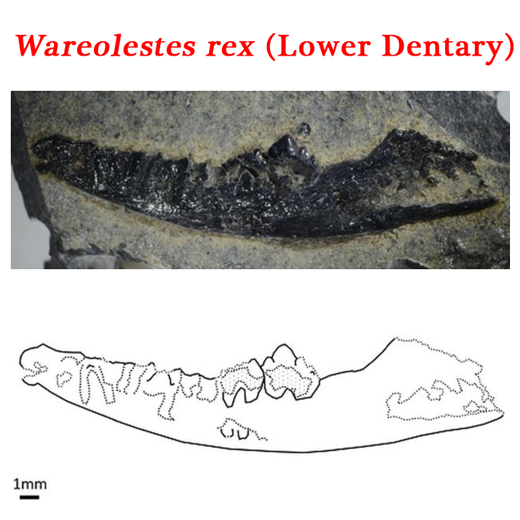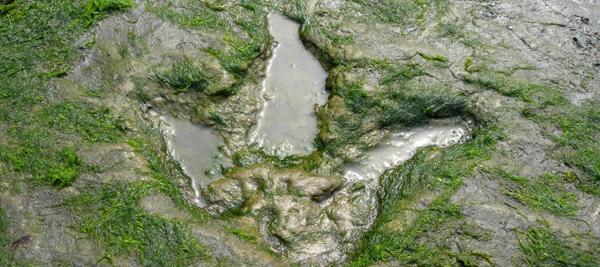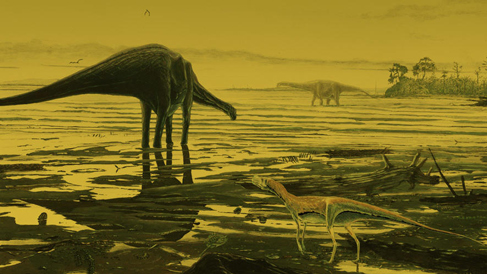Vital Legal Protection for Isle of Sky Fossil Sites
Some very good news for scientists, conservationists and for anyone concerned with protecting the natural heritage of the UK. Internationally-recognised and extremely important Jurassic-aged fossil sites on the Scottish island of Skye, containing rare evidence of how dinosaurs and early mammals lived many millions of years ago, have been granted greater legal status. This will help to ensure their protection for future generations and provide greater security for future fossil discoveries.
A Tridactyl Dinosaur Footprint Preserved on the Shoreline of the Isle of Skye
Picture credit: Colin MacFadyen (Scottish National Heritage)
Legal Protection for Isle of Skye Fossils
Here is the full press release provided by Scottish Natural Heritage with some additional information from Everything Dinosaur:
Minister for Rural Affairs and the Natural Environment, Mairi Gougeon, had signed a Nature Conservation Order (NCO) at Staffin Museum, home of dinosaur bones and footprints found nearby on the Isle of Skye. The key aim of the NCO is to prevent rare vertebrate fossils from being damaged through irresponsible collection and removal from Skye’s globally important fossil sites. Importantly, the NCO aims to encourage local people and the wider public to take an interest in and report any potentially important fossil finds.
A View of the Isle of Skye in the Middle Jurassic
Picture credit: Jon Hoad
Aiming to Deter Irresponsible Fossil Collecting
In the past, important fossil discoveries have been damaged by hammering, with specimens taken from the island and moved to private collections. In 2016, an attempt to take a plaster cast of a dinosaur footprint at An Corran risked significant damage to a feature that has become an important tourist attraction. To read Everything Dinosaur’s article about this: 165-million-year-old dinosaur footprints damaged.
Known as the dinosaur capital of Scotland, the rich Middle Jurassic fossil fauna of Skye is gradually being revealed with new discoveries continuing to be made. These include some of the first fossil evidence of dinosaur parenting. Housed at Staffin Museum, a rock slab shows the footprints of baby dinosaurs, together with the print of an adult. It is expected that Skye is also home to fossil remains of flying reptiles, and confirmation of this will firmly place the island in the international dinosaur hall of fame. The new legal protection will help to deter irresponsible fossil collecting on the island.
Commenting on the Legal Protection for the Isle of Skye Fossils
Commenting on the significance of the increased protection, Minister for the Natural Environment Mairi Gougeon said:
“Skye lays claim to the most significant dinosaur discoveries of Scotland’s Jurassic past and this Nature Conservation Order is a vital step in protecting and preserving this important part of our natural heritage for future generations. The Order gives extra legal protection to these special sites whilst providing for important artefacts to be collected responsibly for science and public exhibition, as Dugald Ross of the Staffin Museum has been doing since his first important discovery in 1982. I hope the Order gives even greater awareness of the significance of these important sites, and the important and valuable role everyone has in helping protect them.”
Everything Dinosaur team members have corresponded with Dugald Ross in the past. Sadly, our communications have mostly been about damage to fossil deposits and suspected thefts of fossil material.
To read an article from 2011 that reported on the damage caused to an important fossil site on the Isle of Skye: Important Jurassic Fossil Site Ransacked.
Colin MacFadyen, a geologist at Scottish National Heritage stated:
“This vital legal protection is important to ensure Skye’s unique dinosaur heritage is available for everyone to learn from and enjoy. The NCO covers areas of coastline where 165 million-year-old Middle Jurassic sedimentary rocks are gradually being eroded by the sea. It is crucial that the footprints and actual skeletal remains of dinosaurs and other vertebrates, that are being revealed by nature are protected. These fabulous fossil finds can help answer crucial questions about ancient ecosystems and pave the way for exciting advances in our understanding of vertebrate evolution.”
Dinosaurs and Mammal Fossil Evidence Too
The Minch Basin region of north-western Scotland partially consists of strata laid down in the Middle Jurassic, an important time in the evolution of the Dinosauria with many new families evolving. This period in Earth’s history also marks the evolution of a number of mammal genera. Unfortunately, there are very few fossil bearing exposures around the world that record evidence of life on our planet during this important period of terrestrial vertebrate evolution. The Isle of Skye is one of these locations, hence this new legal protection is extremely important.
Early Mammal Fossils Have Also Been Found on the Isle of Skye

Staffin Museum owner Dugald Ross added:
“Everyone has a role to play in making the Order a success, and we are encouraging local people who think they may have found a vertebrate fossil – or a dinosaur bone or tooth – to contact Staffin Museum for advice. We are encouraging everyone to find, report and help protect – but not collect – Skye’s wonderful dinosaur heritage.”
Everything Dinosaur acknowledges the assistance of a press release from Scottish Natural Heritage in the compilation of this article.
The Everything Dinosaur website: Everything Dinosaur.








Leave A Comment